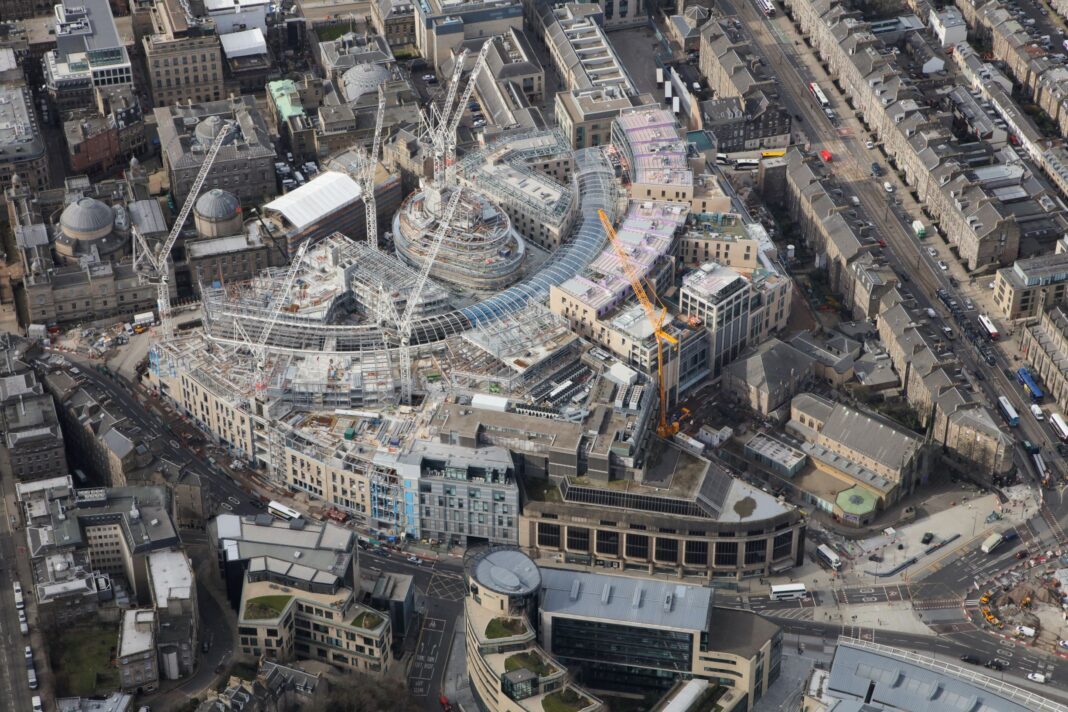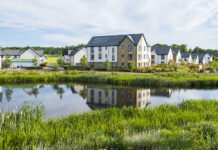
DIGITAL collaboration played a key role in progressing design development on the £1 billion Edinburgh St James project during lockdown, according to the architectural practice at the heart of the plans.
Designers, engineers and contractors utilised technology to ensure the project could adopt a ‘business as usual’ approach for design development and coordination during the 12-week period when on-site activities were suspended.
The project team has relied heavily on tools such as Building Information Modelling (BIM) and integrated digital twin solutions.
BDP Glasgow Studio is the lead consultant and technical architect for the design of Edinburgh St James – Nuveen Real Estate’s development – and is delivering the masterplan as part of the Laing O’Rourke construction team.
Chris Hughes, architect associate at BDP Glasgow Studio, has worked on large projects using BIM over the last eight years. He explained, “BDP’s BIM working practices had been progressively refined over a series of projects, gradually increasing in scale and complexity. Silverburn shopping centre phase 3 in Glasgow, completed in 2015, was the final step in refining this process and validated that a large-scale shopping experience for the 21st century could be designed and delivered using the fully integrated BIM environment.

“This focus on a collaborative working environment with all information being shared digitally was the perfect experience needed for the larger and more complex project at Edinburgh St James and ultimately led to BDP being the first architectural practice in Scotland to gain BIM level 2 certification. The great strides made over the last decade to refine working practices in a BIM environment are ideally suited to how we now need to work to within the socially distanced protocols.”
Edinburgh St James is in the final stages of delivery. A mature supply chain is in place and fully engaged, and construction is progressing across all areas of the development
The way BIM is being utilised is part of a process that allows all the parties involved in the project to collaborate. The 3D model of the site is being used in real time. Architects, engineers, client and contractor are all sharing a digital process and using the model as a virtual representation of the physical complex of buildings to validate construction processes, sequencing and assemblies long before materials arrive on site.
Chris Hughes added, “The Edinburgh St James team has created a virtual simulation of the site, fusing Design for Manufacture and Assembly (DFMA) grade model contributions, design intent models and point cloud survey data, to create a virtual representation that contains as retained, as built, as fabricated and as proposed information.
“This virtual representation is reviewed remotely by all parties thus allowing emerging proposals to be interrogated and tested in three dimensions before further fabrication takes place.
“We have clear process and guidance giving confidence in the resilience of the digital strategies we have in place. The complex model also facilitates virtual inspections, thus avoiding the need to physically visit the site. The project employs a cloud based virtual reality capturing system, similar to that used in Google Maps. This allows users to interrogate the sequence of construction works.
“We can all sit at home with our kids doing virtual lessons and the cat snoozing in the background and understand and track elements through a time sequence, from seeing a stone panel at the factory for inspection, seeing it delivered to site and its final position. We can also look at plans that show the detailed instructions used by the contractor on how it is assembled and installed if we need to.”
Laing O’Rourke has an in-house DFMA-based supply chain and BIM capabilities, which uses fabrication data from the model to drive an offsite manufacturing process. The model allows the creation of design intent, to develop into worked up design proposals to specialist subcontractors. This process is also said to include close collaboration between the UK team and elements of the supply chain based overseas. The systems are all in place from an early stage to enable detailed design and coordination to be undertaken remotely.
Chris said, “I am an architect who enjoys designing with a digital model. But the model is only as good as the input. The beauty of BIM is that is simply a template for all types of styles of working. It allows for those who prefer drawing to have their ideas included within the model. On virtual calls we can all comment on the model and add comments and each time it is updated in real time. The design intent is intact, and any errors can be viewed and changed.
“At Edinburgh St James, whilst onsite works ceased, design, coordination and elements of offsite manufacturing continued. The timeline for delivery can be established and order of works created. In the meantime the client can use the model to view the progress of the design remotely and offer other suppliers or end users the opportunity to use virtual reality to walk around the space and determine their own plans for the fit out and completion.
“Virtual design and construction models by the completion of a project can be used as a tool to allow you to know the story of the building and you can then use this knowledge to predict outcomes for energy efficiency for example. We are extending its use to relate works on site to the design progression. The regular cloud point surveys from site and supply chain models of fabricated materials can all be connected back to the twin digital model. For instance, at the key interfaces between the retained parts of the scheme and the new build, we fuse point cloud surveys with DFMA information from the precast panels installed. We also consider CADCAM information from the glazing supply chain, fabricated but not yet installed, to refine design intent solutions.
“In a new world of construction where remote working is necessary, the virtual building model becomes the one the designers and main contractor use to develop solutions such as design quality, precision and durability, at the same time seeking to minimise the impact on elements that are existing, fabricated and already in place.
“In the current climate of social distancing, with the protocols we have adopted, there is less need for designers to visit a site, however this will still be necessary from time to time.
“Although I am committed to the model, I am an architect and there is a need to see the building that you have dreamed about, particularly if you have invested so much time in its aesthetic and you can see the impact it will have on future generations. What we do know from working on Edinburgh St James remotely is, we are not hanging up our hard hats yet as there is always a place for us on site, but we recognise we have established real collaboration and progress using digital platforms and this will play have a key role to place in the new world order.”











